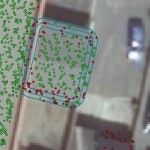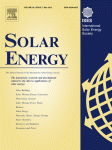Associate Professor Joshua M. Pearce (MSE/ECE) authored an article, “The Case for Open Source Appropriate Technology,” published in the journal Environment, Development and Sustainability (Volume14, pp 425-431, 2012).
The vice president for research is pleased to announce this year’s recipients of the Research Excellence Fund Awards, which total $515,000. Mark Plichta is among the recipients of an Infrastructure Enhancement Grant.
Read more at Tech Today.
Associate Professor Joshua Pearce (MSE/IMP), Associate Professor Durdu Guney (ECE/IMP), Associate Professor Paul Bergstrom (ECE/IMP) and Professor Emeritus Anand Kulkarni (ECE/IMP), “DMREF: Optical Enhancement and Engineering of Multi-junction Indium Gallium Nitride Solar Photovoltaic Devices,” NSF
 Associate Professor Joshua Pearce (MSE/ECE) coauthored an article, “The Application of LiDAR to Assessment of Rooftop Solar Photovoltaic Deployment Potential in a Municipal District Unit,” in the journal, Sensors.
Associate Professor Joshua Pearce (MSE/ECE) coauthored an article, “The Application of LiDAR to Assessment of Rooftop Solar Photovoltaic Deployment Potential in a Municipal District Unit,” in the journal, Sensors.
John & Virginia Towers Distinguished Lecture Series
Abstract
Cellulosic biomass represents a potential resource for sustainable production of fuels and chemicals. When cellulose is hydrolyzed using mineral acids as catalysts, dark-colored, tarry solids known as humins form as undesirable by-products. The formation and growth of humins have been investigated using small batch reactors, and the resulting humins have been characterized, primarily using scanning electron microscopy and infrared spectroscopy. The aqueous phase free energies of proposed reaction intermediates have been computed using quantum chemistry. The experimental and computational results are consistent with a sequential pathway for the formation of humins. The primary reaction proceeds through the sequential conversions of cellulose to glucose (perhaps) to fructose to HMF to levulinic acid. The predominant pathway for the formation of humins involves the conversion to HMF to 2,5-dioxo- 6-hydroxyhexanal (DHH). DHH rapidly undergoes aldol addition/condensation with available aldehydes or ketones. The resulting adduct then polymerizes to form humins. The experimental studies have shown that humin morphology, size and size distribution are affected by solvent choice. It has also been established that chemical functional groups can be added to the humins during or after their formation. These finding might lead to ways to convert humins from a waste byproduct to a more valuable commodity.
Bio: Dr. Lund is a SUNY Distinguished Professor. He was a department chair from 1997 to 2006. He obtained his B. S. from Purdue University in 1976 and Ph. D. from University of Wisconsin–Madison in 1981. His research interests include heterogeneous catalysis for energy and environmental applications, reaction engineering of membrane reactors, and biomass conversion. He received many awards, including NSF Presidential Young Investigator, SUNY Chancellor’s Award for Excellence in Teaching, and Lilly Teaching Fellow. He published more than 70 peer-reviewed papers.
 Associate Professor Joshua Pearce (MSE/ECE) and a colleague coauthored an article, “Incorporating Shading Losses in Solar Photovoltaic Potential Assessment at the Municipal Scale,” in the journal Solar Energy, volume 86(5), pp. 1245–1260 (2012).
Associate Professor Joshua Pearce (MSE/ECE) and a colleague coauthored an article, “Incorporating Shading Losses in Solar Photovoltaic Potential Assessment at the Municipal Scale,” in the journal Solar Energy, volume 86(5), pp. 1245–1260 (2012).
 Associate Professor Yun Hang Hu (MSE) attended the 243rd meeting of the American Chemical Society (ACS) in San Diego in late March.
Associate Professor Yun Hang Hu (MSE) attended the 243rd meeting of the American Chemical Society (ACS) in San Diego in late March.
Hu was the program chair of the ACS fuel chemistry division, which featured 68 sessions and 607 papers (a record since 1961) presented by scientists worldwide.
With more than 164,000 members, the ACS is the world’s largest scientific society and one of the world’s leading sources of authoritative scientific information.
The fuel chemistry division (renamed energy and fuels division) is one of 32 technical divisions.
Read more at Tech Today.
Associate Professor Yun Hang Hu (MSE/IMP), Professor and Chair Ravindra Pandey (Physics/IMP), Assistant Professor Wenzhen Li (ChE/IMP) and Assistant Professor Kazuya Tajiri (ME-EM/IMP), “SEP: Graphene-based Electrodes for Sustainable Energy Conversion,” NSF
 2012 Undergraduate Expo Entries
2012 Undergraduate Expo Entries
SENIOR DESIGN
Title and Representative
Economic Recovery of Alloying Elements from Grinding Swarf
Alicia Steele
Reduce Distortion in Ferritic Nitrocarburizing of Gray Iron
Carol Deming
Fatigue in Stainless Steel Components Produced by Powder Metallurgy & Hot Isostatic Pressing
Samantha Leonard
EZAC Creep Testing Team
Deane Kyle
Effects of Mn and Sn on Ductile Iron
Dale Goodloe
Residual Stress of Gray Iron Brake Rotors
Carol Dem
Waupaca FNC Case Depth
Ashwin, Vekaria
ENTERPRISE TEAMS
Advanced Metalworks Enterprise
Zac Dvorak